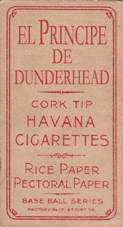What cards are safe from phoneying up?
4 posters
Page 1 of 1
 Re: What cards are safe from phoneying up?
Re: What cards are safe from phoneying up?
Mayos are pretty safe. They used a pretty unique photo reproduction style, so if you know what you are looking for, there is no way to fake one. Then there is the issue of having to reproduce the black front and back and make look vintage. Just way to many things going on with this set for anyone but a novice to get fooled by a reprint.
Jay
Jay
 Re: What cards are safe from phoneying up?
Re: What cards are safe from phoneying up?
T205's and Ramlys would be really tough to reproduce given their gold borders. The flaking/wear/discoloration you often see on the borders would be nearly impossible to replicate. Reprints from these sets show up from time to time, and they're not even close.
 Re: What cards are safe from phoneying up?
Re: What cards are safe from phoneying up?
Well, I've never seen a legitimate attempt to produce a gradeable counterfeit OJ, but since it is only a photograph, I bet my local drugstore could reproduce all of mine worthy of duplication in one or two passes. I'm sure that they could reproduce the gloss, however, the difference in the photographic process would be discernable to anyone who knew what he was looking at, and the backing would be identifiable as modern to anyone with a black light. Of course period backing material is available at modest cost, and replacement period adhesive can simply be made from modern materials which have not yet had brighteners added to them. This would be flour paste.
In order to make flour paste, you simply add flour to water and mix it to an acceptable consistency. Flour is made from wheat as follows:
An 1884 description of producing flour for use in baking bread, cakes, or pastry. From Boston Cookery School Cook Book, Mrs. D. A. Lincoln, 1884.
Difficulty: Hard
Time Required: Long
Here's How:
1. Choose wheat grown in the Red River region.
2. Break off the germinal point of each grain by using "ending stones."
3. Send grain through corrugated iron rollers, with shallow spiral grooves and rounded ridges.
4. Crush between these rollers, two sets grooved in opposite directions.
5. Separate the middlings (starchy parts) from the bran or tailings.
6. Discard the bran.
7. Pass the middlings through ten bolting-cloths.
8. Pass the resulting flour through finer corrugating machines to make various grades: fine, super-fine, fancy.
9. Use the flour to make bread, cakes, or pastry.
I'm sure that the "Red River" region is not the only place for acceptable wheat. The rest - I don't know about.
In order to make flour paste, you simply add flour to water and mix it to an acceptable consistency. Flour is made from wheat as follows:
An 1884 description of producing flour for use in baking bread, cakes, or pastry. From Boston Cookery School Cook Book, Mrs. D. A. Lincoln, 1884.
Difficulty: Hard
Time Required: Long
Here's How:
1. Choose wheat grown in the Red River region.
2. Break off the germinal point of each grain by using "ending stones."
3. Send grain through corrugated iron rollers, with shallow spiral grooves and rounded ridges.
4. Crush between these rollers, two sets grooved in opposite directions.
5. Separate the middlings (starchy parts) from the bran or tailings.
6. Discard the bran.
7. Pass the middlings through ten bolting-cloths.
8. Pass the resulting flour through finer corrugating machines to make various grades: fine, super-fine, fancy.
9. Use the flour to make bread, cakes, or pastry.
I'm sure that the "Red River" region is not the only place for acceptable wheat. The rest - I don't know about.
Last edited by TheRiddler on Wed Feb 04, 2009 5:30 pm; edited 1 time in total (Reason for editing : To add: the recipe above seems to be for the production of a substantial quantity of flour. For the purposes of making up a batch of glue, I would think that a mortar and pestle would suffice.)

TheRiddler- Custom

- Posts : 1404
Trader Points :



 Re: What cards are safe from phoneying up?
Re: What cards are safe from phoneying up?
Call me jaded but it's my opinion that if it was made once, it could be made again. Although, I do believe some are safer than others...Mayo's are a good example.
The problem with many advanced collectors and grading companies is that they only think of simple alterations or relate to some that have already been seen...typically after it's already in the hobby (the Doyle name reprint is a good example). If you open your mind and think wayyyy outside of the box, anything is possible.
BTW, there is a doctoring technique to make newer paper look old under a blacklight.
I would take that bet.
.
.
.
The problem with many advanced collectors and grading companies is that they only think of simple alterations or relate to some that have already been seen...typically after it's already in the hobby (the Doyle name reprint is a good example). If you open your mind and think wayyyy outside of the box, anything is possible.
BTW, there is a doctoring technique to make newer paper look old under a blacklight.
The flaking/wear/discoloration you often see on the borders would be nearly impossible to replicate.
I would take that bet.
.
.
.
 Similar topics
Similar topics» Is it better to have more cards, or higher grade cards?
» TPG giving grades to hand cut cards/cards missing coupons
» Large group of Pre WW2 cards for sale - new cards added
» Large group of Pre WW2 cards for sale - new cards added
» Possible stolen cards via USPS- Cards found!
» TPG giving grades to hand cut cards/cards missing coupons
» Large group of Pre WW2 cards for sale - new cards added
» Large group of Pre WW2 cards for sale - new cards added
» Possible stolen cards via USPS- Cards found!
Page 1 of 1
Permissions in this forum:
You cannot reply to topics in this forum|
|
|



